B301: FDI Attraction, National Advantage & Innovation Policies
VerifiedAdded on 2023/05/29
|6
|2129
|95
Report
AI Summary
This assignment provides a comprehensive analysis of attracting and retaining Foreign Direct Investment (FDI) through the application of Michael Porter's Diamond of National Advantage. It discusses the critical determinants of national advantage, including factors of production, demand conditions, related and supporting industries, and organizational strategy. The report also highlights the role of government policies in enhancing industrial innovation and upgrading capabilities, focusing on incentivizing SMEs, providing subsidies, establishing financial institutions, and fostering competition. The analysis emphasizes the importance of both company/industry-related and country-specific determinants in influencing FDI decisions, considering factors like taxation policies, resource availability, and macroeconomic conditions. The document concludes that government policies play a crucial role in fostering innovation and driving economic growth.
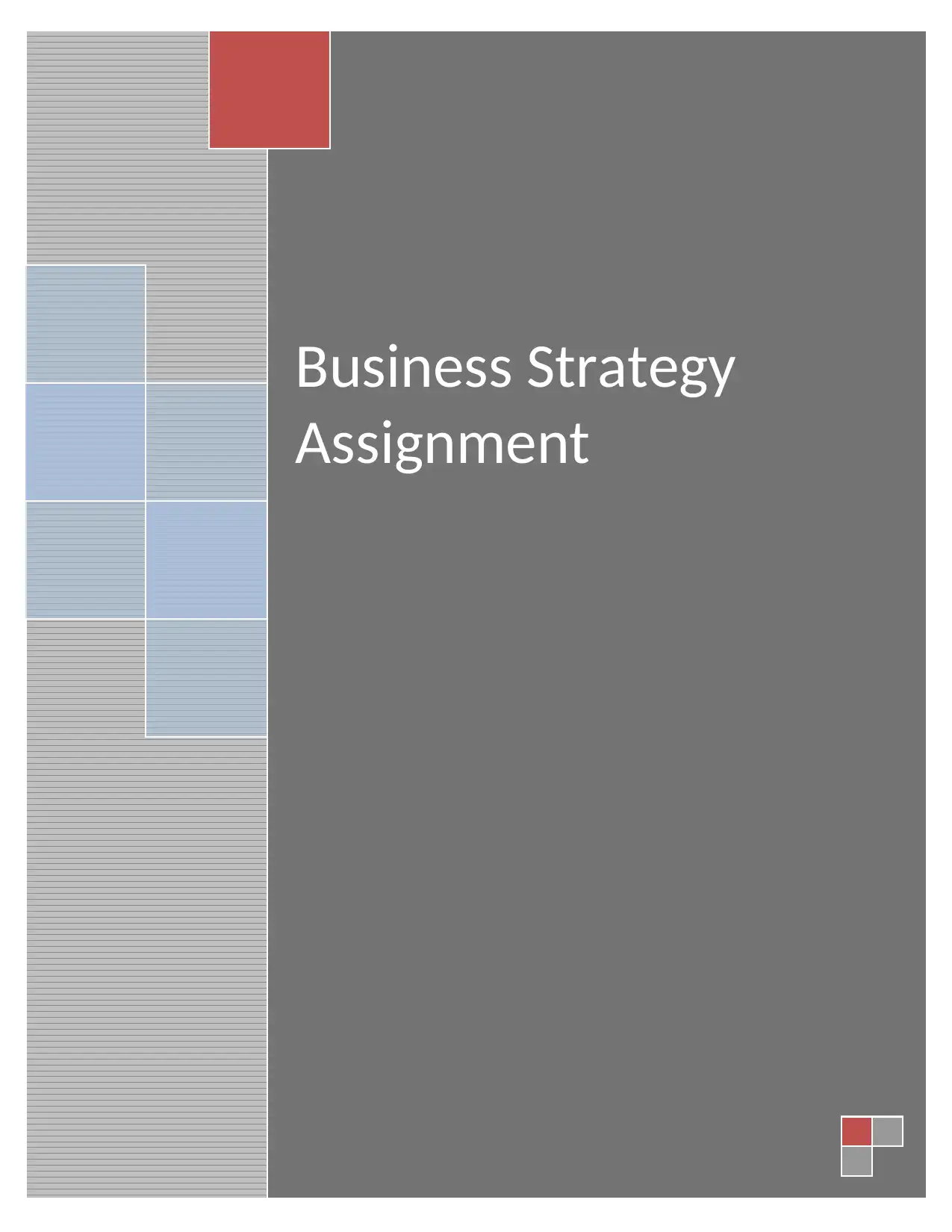
Business Strategy
Assignment
Assignment
Paraphrase This Document
Need a fresh take? Get an instant paraphrase of this document with our AI Paraphraser
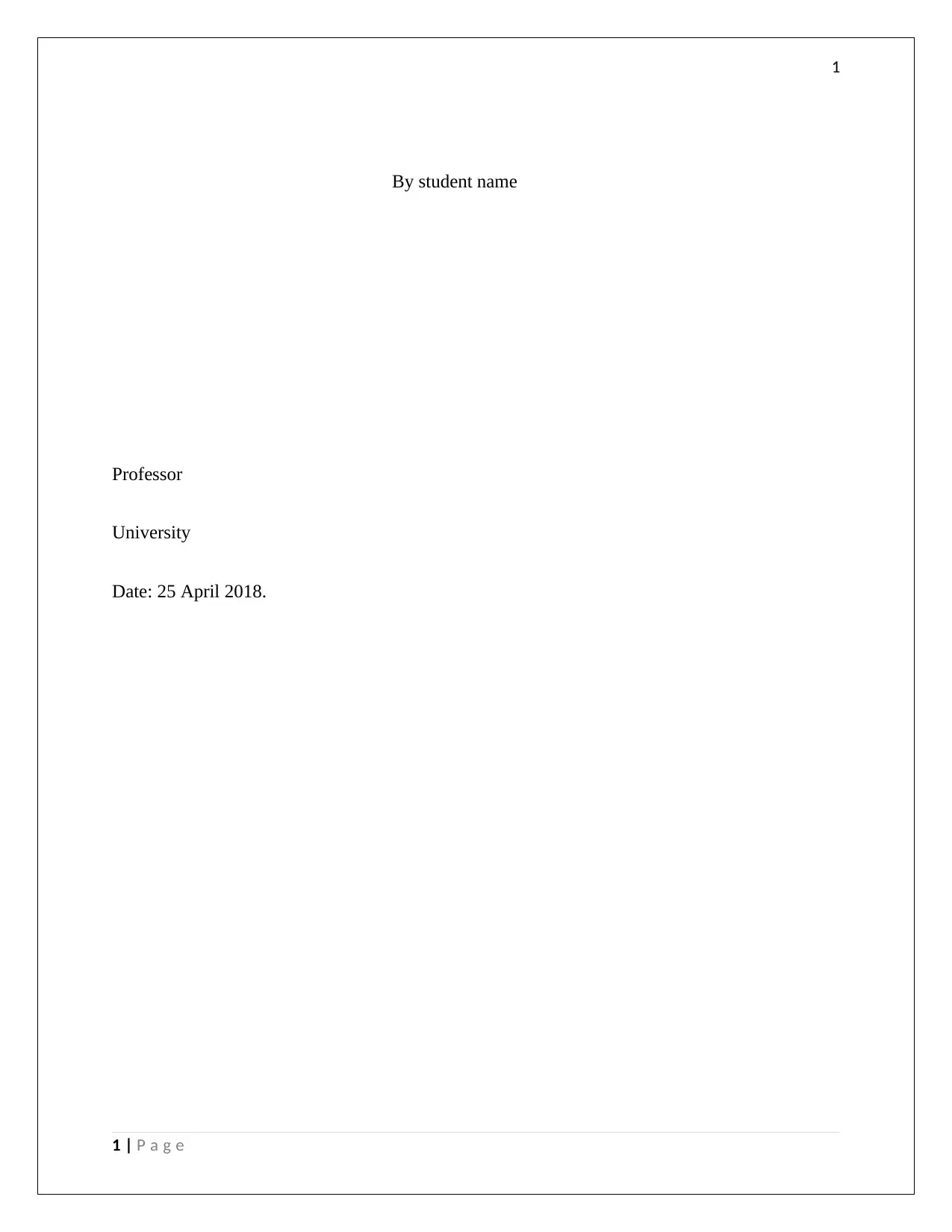
1
By student name
Professor
University
Date: 25 April 2018.
1 | P a g e
By student name
Professor
University
Date: 25 April 2018.
1 | P a g e
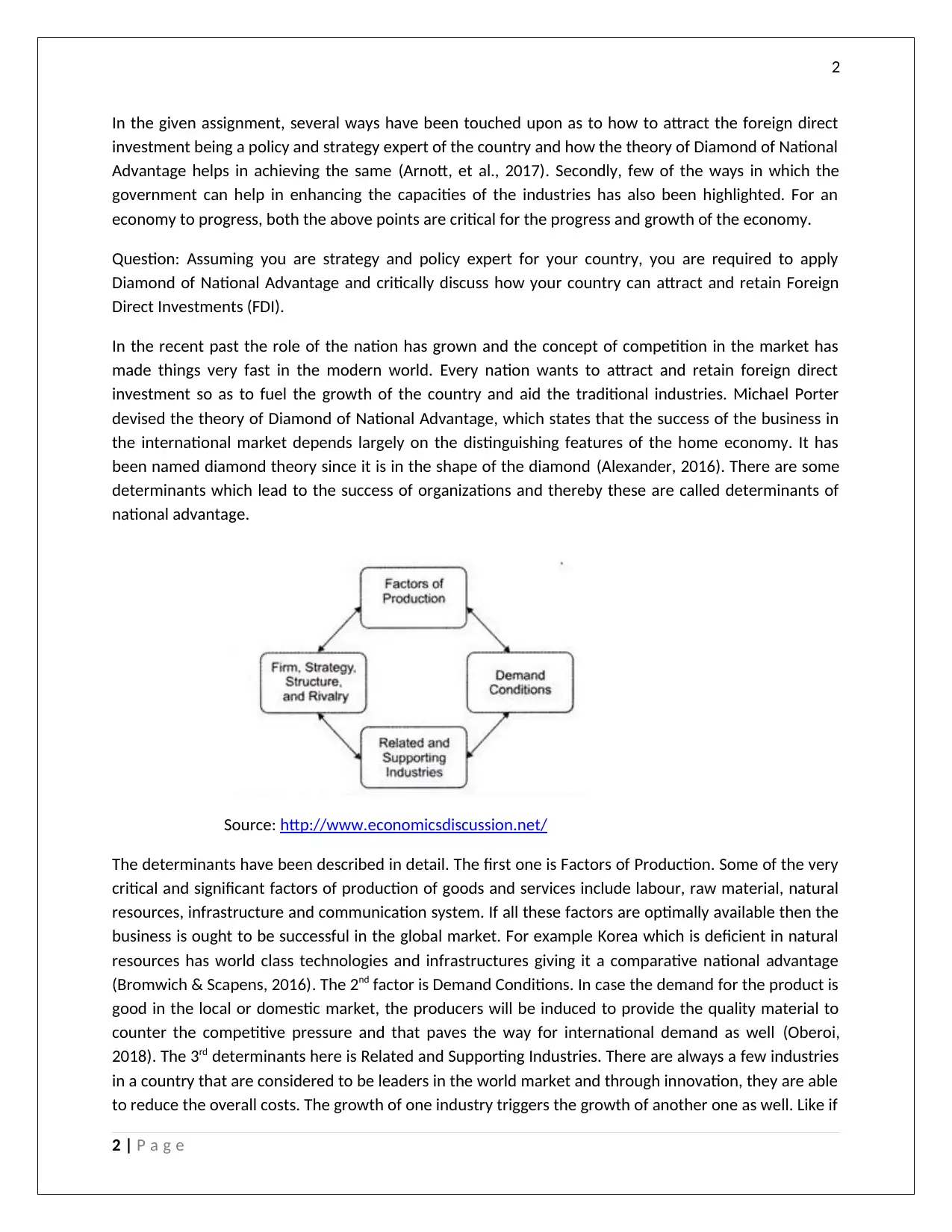
2
In the given assignment, several ways have been touched upon as to how to attract the foreign direct
investment being a policy and strategy expert of the country and how the theory of Diamond of National
Advantage helps in achieving the same (Arnott, et al., 2017). Secondly, few of the ways in which the
government can help in enhancing the capacities of the industries has also been highlighted. For an
economy to progress, both the above points are critical for the progress and growth of the economy.
Question: Assuming you are strategy and policy expert for your country, you are required to apply
Diamond of National Advantage and critically discuss how your country can attract and retain Foreign
Direct Investments (FDI).
In the recent past the role of the nation has grown and the concept of competition in the market has
made things very fast in the modern world. Every nation wants to attract and retain foreign direct
investment so as to fuel the growth of the country and aid the traditional industries. Michael Porter
devised the theory of Diamond of National Advantage, which states that the success of the business in
the international market depends largely on the distinguishing features of the home economy. It has
been named diamond theory since it is in the shape of the diamond (Alexander, 2016). There are some
determinants which lead to the success of organizations and thereby these are called determinants of
national advantage.
Source: http://www.economicsdiscussion.net/
The determinants have been described in detail. The first one is Factors of Production. Some of the very
critical and significant factors of production of goods and services include labour, raw material, natural
resources, infrastructure and communication system. If all these factors are optimally available then the
business is ought to be successful in the global market. For example Korea which is deficient in natural
resources has world class technologies and infrastructures giving it a comparative national advantage
(Bromwich & Scapens, 2016). The 2nd factor is Demand Conditions. In case the demand for the product is
good in the local or domestic market, the producers will be induced to provide the quality material to
counter the competitive pressure and that paves the way for international demand as well (Oberoi,
2018). The 3rd determinants here is Related and Supporting Industries. There are always a few industries
in a country that are considered to be leaders in the world market and through innovation, they are able
to reduce the overall costs. The growth of one industry triggers the growth of another one as well. Like if
2 | P a g e
In the given assignment, several ways have been touched upon as to how to attract the foreign direct
investment being a policy and strategy expert of the country and how the theory of Diamond of National
Advantage helps in achieving the same (Arnott, et al., 2017). Secondly, few of the ways in which the
government can help in enhancing the capacities of the industries has also been highlighted. For an
economy to progress, both the above points are critical for the progress and growth of the economy.
Question: Assuming you are strategy and policy expert for your country, you are required to apply
Diamond of National Advantage and critically discuss how your country can attract and retain Foreign
Direct Investments (FDI).
In the recent past the role of the nation has grown and the concept of competition in the market has
made things very fast in the modern world. Every nation wants to attract and retain foreign direct
investment so as to fuel the growth of the country and aid the traditional industries. Michael Porter
devised the theory of Diamond of National Advantage, which states that the success of the business in
the international market depends largely on the distinguishing features of the home economy. It has
been named diamond theory since it is in the shape of the diamond (Alexander, 2016). There are some
determinants which lead to the success of organizations and thereby these are called determinants of
national advantage.
Source: http://www.economicsdiscussion.net/
The determinants have been described in detail. The first one is Factors of Production. Some of the very
critical and significant factors of production of goods and services include labour, raw material, natural
resources, infrastructure and communication system. If all these factors are optimally available then the
business is ought to be successful in the global market. For example Korea which is deficient in natural
resources has world class technologies and infrastructures giving it a comparative national advantage
(Bromwich & Scapens, 2016). The 2nd factor is Demand Conditions. In case the demand for the product is
good in the local or domestic market, the producers will be induced to provide the quality material to
counter the competitive pressure and that paves the way for international demand as well (Oberoi,
2018). The 3rd determinants here is Related and Supporting Industries. There are always a few industries
in a country that are considered to be leaders in the world market and through innovation, they are able
to reduce the overall costs. The growth of one industry triggers the growth of another one as well. Like if
2 | P a g e
⊘ This is a preview!⊘
Do you want full access?
Subscribe today to unlock all pages.

Trusted by 1+ million students worldwide
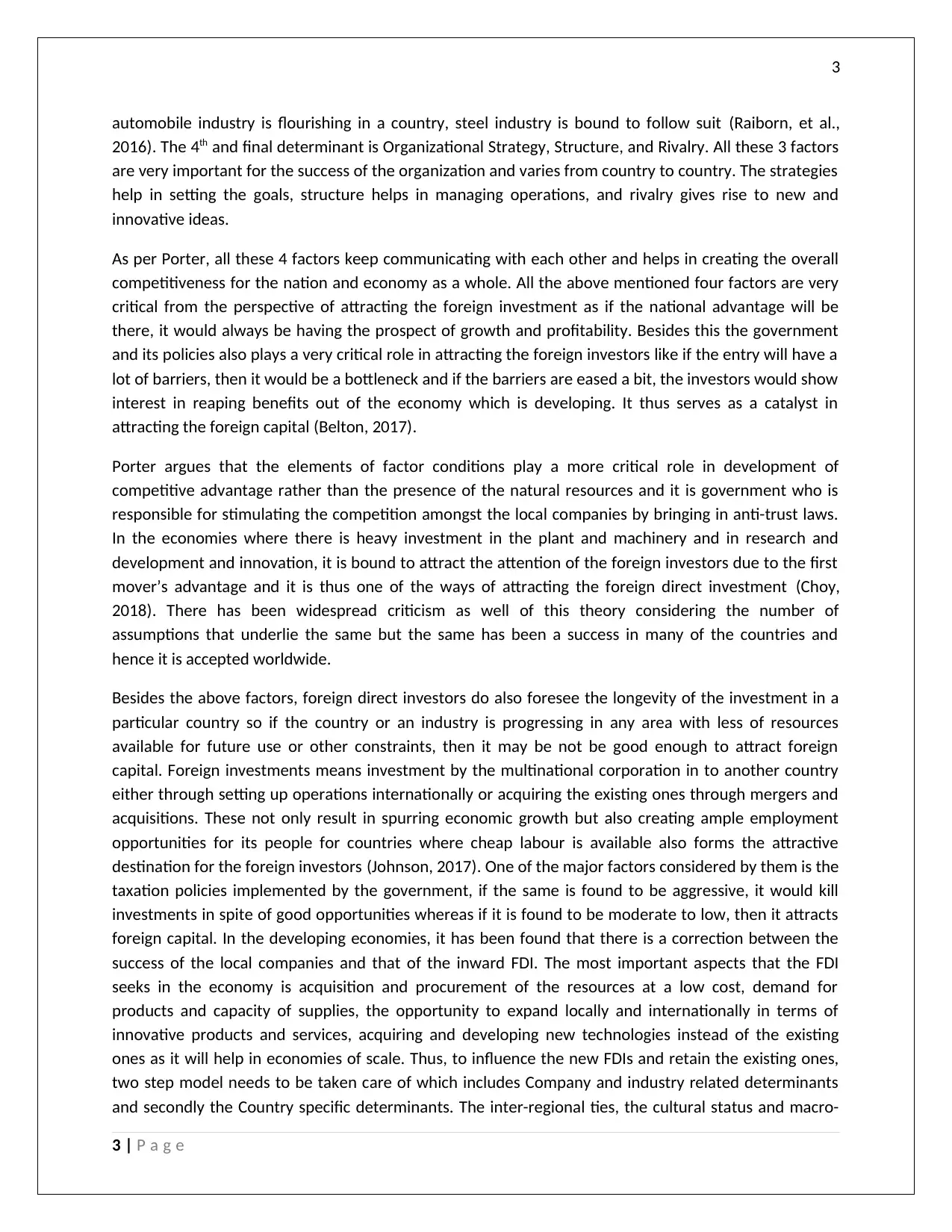
3
automobile industry is flourishing in a country, steel industry is bound to follow suit (Raiborn, et al.,
2016). The 4th and final determinant is Organizational Strategy, Structure, and Rivalry. All these 3 factors
are very important for the success of the organization and varies from country to country. The strategies
help in setting the goals, structure helps in managing operations, and rivalry gives rise to new and
innovative ideas.
As per Porter, all these 4 factors keep communicating with each other and helps in creating the overall
competitiveness for the nation and economy as a whole. All the above mentioned four factors are very
critical from the perspective of attracting the foreign investment as if the national advantage will be
there, it would always be having the prospect of growth and profitability. Besides this the government
and its policies also plays a very critical role in attracting the foreign investors like if the entry will have a
lot of barriers, then it would be a bottleneck and if the barriers are eased a bit, the investors would show
interest in reaping benefits out of the economy which is developing. It thus serves as a catalyst in
attracting the foreign capital (Belton, 2017).
Porter argues that the elements of factor conditions play a more critical role in development of
competitive advantage rather than the presence of the natural resources and it is government who is
responsible for stimulating the competition amongst the local companies by bringing in anti-trust laws.
In the economies where there is heavy investment in the plant and machinery and in research and
development and innovation, it is bound to attract the attention of the foreign investors due to the first
mover’s advantage and it is thus one of the ways of attracting the foreign direct investment (Choy,
2018). There has been widespread criticism as well of this theory considering the number of
assumptions that underlie the same but the same has been a success in many of the countries and
hence it is accepted worldwide.
Besides the above factors, foreign direct investors do also foresee the longevity of the investment in a
particular country so if the country or an industry is progressing in any area with less of resources
available for future use or other constraints, then it may be not be good enough to attract foreign
capital. Foreign investments means investment by the multinational corporation in to another country
either through setting up operations internationally or acquiring the existing ones through mergers and
acquisitions. These not only result in spurring economic growth but also creating ample employment
opportunities for its people for countries where cheap labour is available also forms the attractive
destination for the foreign investors (Johnson, 2017). One of the major factors considered by them is the
taxation policies implemented by the government, if the same is found to be aggressive, it would kill
investments in spite of good opportunities whereas if it is found to be moderate to low, then it attracts
foreign capital. In the developing economies, it has been found that there is a correction between the
success of the local companies and that of the inward FDI. The most important aspects that the FDI
seeks in the economy is acquisition and procurement of the resources at a low cost, demand for
products and capacity of supplies, the opportunity to expand locally and internationally in terms of
innovative products and services, acquiring and developing new technologies instead of the existing
ones as it will help in economies of scale. Thus, to influence the new FDIs and retain the existing ones,
two step model needs to be taken care of which includes Company and industry related determinants
and secondly the Country specific determinants. The inter-regional ties, the cultural status and macro-
3 | P a g e
automobile industry is flourishing in a country, steel industry is bound to follow suit (Raiborn, et al.,
2016). The 4th and final determinant is Organizational Strategy, Structure, and Rivalry. All these 3 factors
are very important for the success of the organization and varies from country to country. The strategies
help in setting the goals, structure helps in managing operations, and rivalry gives rise to new and
innovative ideas.
As per Porter, all these 4 factors keep communicating with each other and helps in creating the overall
competitiveness for the nation and economy as a whole. All the above mentioned four factors are very
critical from the perspective of attracting the foreign investment as if the national advantage will be
there, it would always be having the prospect of growth and profitability. Besides this the government
and its policies also plays a very critical role in attracting the foreign investors like if the entry will have a
lot of barriers, then it would be a bottleneck and if the barriers are eased a bit, the investors would show
interest in reaping benefits out of the economy which is developing. It thus serves as a catalyst in
attracting the foreign capital (Belton, 2017).
Porter argues that the elements of factor conditions play a more critical role in development of
competitive advantage rather than the presence of the natural resources and it is government who is
responsible for stimulating the competition amongst the local companies by bringing in anti-trust laws.
In the economies where there is heavy investment in the plant and machinery and in research and
development and innovation, it is bound to attract the attention of the foreign investors due to the first
mover’s advantage and it is thus one of the ways of attracting the foreign direct investment (Choy,
2018). There has been widespread criticism as well of this theory considering the number of
assumptions that underlie the same but the same has been a success in many of the countries and
hence it is accepted worldwide.
Besides the above factors, foreign direct investors do also foresee the longevity of the investment in a
particular country so if the country or an industry is progressing in any area with less of resources
available for future use or other constraints, then it may be not be good enough to attract foreign
capital. Foreign investments means investment by the multinational corporation in to another country
either through setting up operations internationally or acquiring the existing ones through mergers and
acquisitions. These not only result in spurring economic growth but also creating ample employment
opportunities for its people for countries where cheap labour is available also forms the attractive
destination for the foreign investors (Johnson, 2017). One of the major factors considered by them is the
taxation policies implemented by the government, if the same is found to be aggressive, it would kill
investments in spite of good opportunities whereas if it is found to be moderate to low, then it attracts
foreign capital. In the developing economies, it has been found that there is a correction between the
success of the local companies and that of the inward FDI. The most important aspects that the FDI
seeks in the economy is acquisition and procurement of the resources at a low cost, demand for
products and capacity of supplies, the opportunity to expand locally and internationally in terms of
innovative products and services, acquiring and developing new technologies instead of the existing
ones as it will help in economies of scale. Thus, to influence the new FDIs and retain the existing ones,
two step model needs to be taken care of which includes Company and industry related determinants
and secondly the Country specific determinants. The inter-regional ties, the cultural status and macro-
3 | P a g e
Paraphrase This Document
Need a fresh take? Get an instant paraphrase of this document with our AI Paraphraser

4
economic factor like that of customer relationship and industry background and evolution also plays a
very critical role in attracting the foreign capital.
Question: As a policy and strategy advisor in your country, critically discuss four basic policies that
government should adopt to enhance the capacity of its industries to innovate and upgrade.
There is a major role which is being played by the government policies in enhancing the capacities of the
industries in a bid to innovate and upgrade. Public investment in the research and development of ICT
and other technologies can bring about a great deal of automation and innovation in the work
processes. Some of the policies in this regard are:
1. Small and medium enterprises form the major segment of the businesses worldwide and thus
incentivising them to innovation, acquisition of skills and technology, global partnerships, etc.
can lead to promotion and expansion of business. This incentivisation can be made in the form
of tax reliefs to these enterprises who will feel encouraged to invest more and more in
innovation and upgradation (Dumay & Baard, 2017).
2. Subsidies play a very major and crucial role when it comes to taking initiative. In case the
companies are aided with new technologies and innovation measures through subsidies and the
burden of financing the same is being shared by the government, then the local industries will
be encouraged to make a move and take the benefit out of it. Furthermore, it will have a boost
on the exports of the country if government provided special incentives and subsidies for those
businesses and enterprises which achieve a certain target in export business. It will not only help
in improving the economic growth of the country but also help in reducing the fiscal deficit and
creating employment opportunities (Kew & Stredwick, 2017).
3. Setting up financial institutions and professional association to help the budding industries and
fuel up the start-up companies so that they can take adequate risk with no issues relating to
financing of the project. In case the governmental organizations help the businesses in terms of
cheap funding through venture capitalists, they will be at more ease to take risks and go for
innovation and advancement. Thus, government can again help here in the form of cheap and
easy funding facilities to the entrepreneurs (Lavassani & Movahedi, 2017).
4. Disadvantages can only be transformed to advantages when the circumstances are created by
the government so as to foster the spirit of competition amongst the individual industries in the
company. The government should be sending proper signals to the local industries to go for
innovation and advancement which will also send the message to the foreign rivals. At the same
time, route for foreign entry should also be made clear such that there is heavy competition and
thus the quality of products and services in improved. Such higher value can be created through
sustainable market segments and active domestic competition (Vieira, et al., 2017).
Thus, from the above discussion and analysis, it can be said that the government and its policies play a
huge role in enhancing the capacities of the industries to innovate and excel. Proper support from
government can help the economy to flourish.
4 | P a g e
economic factor like that of customer relationship and industry background and evolution also plays a
very critical role in attracting the foreign capital.
Question: As a policy and strategy advisor in your country, critically discuss four basic policies that
government should adopt to enhance the capacity of its industries to innovate and upgrade.
There is a major role which is being played by the government policies in enhancing the capacities of the
industries in a bid to innovate and upgrade. Public investment in the research and development of ICT
and other technologies can bring about a great deal of automation and innovation in the work
processes. Some of the policies in this regard are:
1. Small and medium enterprises form the major segment of the businesses worldwide and thus
incentivising them to innovation, acquisition of skills and technology, global partnerships, etc.
can lead to promotion and expansion of business. This incentivisation can be made in the form
of tax reliefs to these enterprises who will feel encouraged to invest more and more in
innovation and upgradation (Dumay & Baard, 2017).
2. Subsidies play a very major and crucial role when it comes to taking initiative. In case the
companies are aided with new technologies and innovation measures through subsidies and the
burden of financing the same is being shared by the government, then the local industries will
be encouraged to make a move and take the benefit out of it. Furthermore, it will have a boost
on the exports of the country if government provided special incentives and subsidies for those
businesses and enterprises which achieve a certain target in export business. It will not only help
in improving the economic growth of the country but also help in reducing the fiscal deficit and
creating employment opportunities (Kew & Stredwick, 2017).
3. Setting up financial institutions and professional association to help the budding industries and
fuel up the start-up companies so that they can take adequate risk with no issues relating to
financing of the project. In case the governmental organizations help the businesses in terms of
cheap funding through venture capitalists, they will be at more ease to take risks and go for
innovation and advancement. Thus, government can again help here in the form of cheap and
easy funding facilities to the entrepreneurs (Lavassani & Movahedi, 2017).
4. Disadvantages can only be transformed to advantages when the circumstances are created by
the government so as to foster the spirit of competition amongst the individual industries in the
company. The government should be sending proper signals to the local industries to go for
innovation and advancement which will also send the message to the foreign rivals. At the same
time, route for foreign entry should also be made clear such that there is heavy competition and
thus the quality of products and services in improved. Such higher value can be created through
sustainable market segments and active domestic competition (Vieira, et al., 2017).
Thus, from the above discussion and analysis, it can be said that the government and its policies play a
huge role in enhancing the capacities of the industries to innovate and excel. Proper support from
government can help the economy to flourish.
4 | P a g e
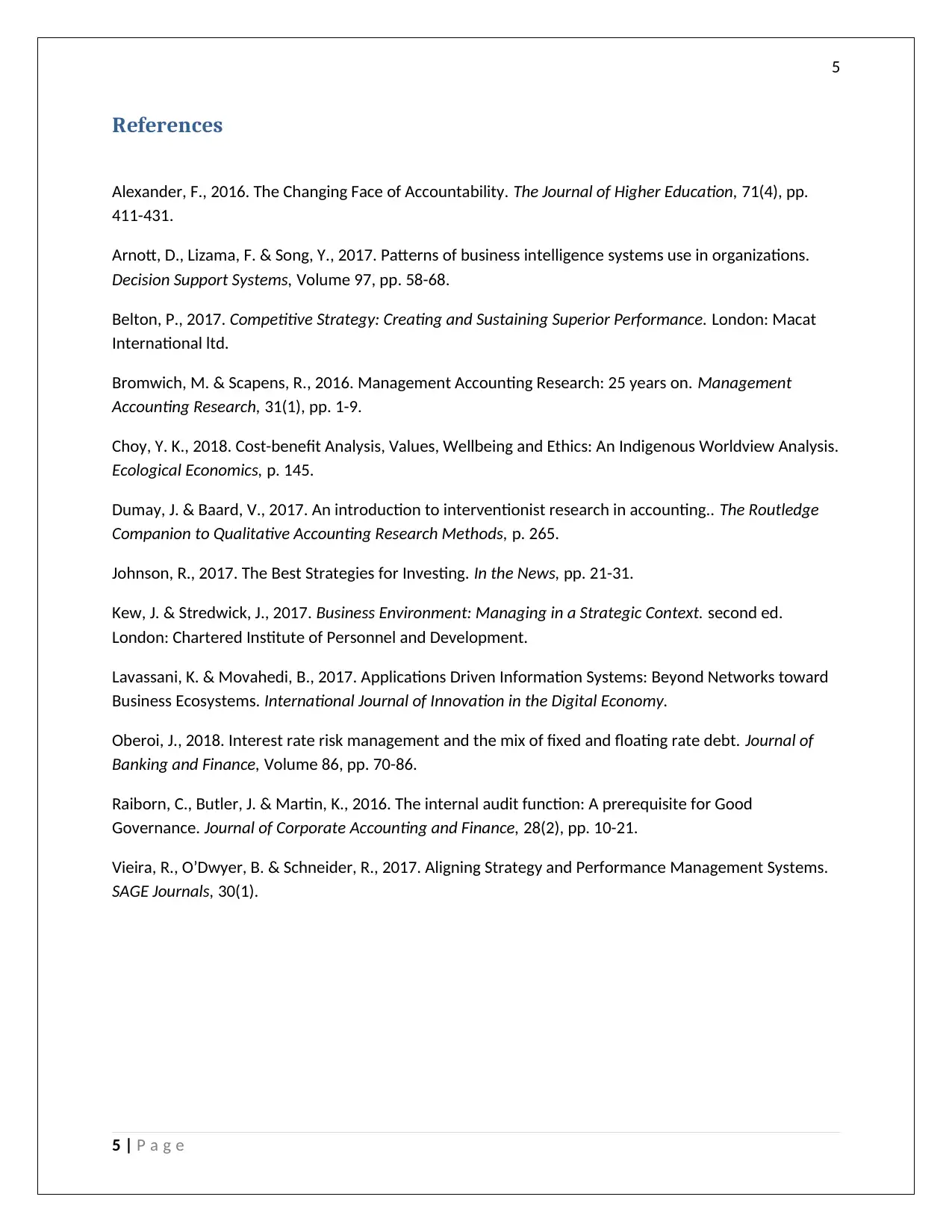
5
References
Alexander, F., 2016. The Changing Face of Accountability. The Journal of Higher Education, 71(4), pp.
411-431.
Arnott, D., Lizama, F. & Song, Y., 2017. Patterns of business intelligence systems use in organizations.
Decision Support Systems, Volume 97, pp. 58-68.
Belton, P., 2017. Competitive Strategy: Creating and Sustaining Superior Performance. London: Macat
International ltd.
Bromwich, M. & Scapens, R., 2016. Management Accounting Research: 25 years on. Management
Accounting Research, 31(1), pp. 1-9.
Choy, Y. K., 2018. Cost-benefit Analysis, Values, Wellbeing and Ethics: An Indigenous Worldview Analysis.
Ecological Economics, p. 145.
Dumay, J. & Baard, V., 2017. An introduction to interventionist research in accounting.. The Routledge
Companion to Qualitative Accounting Research Methods, p. 265.
Johnson, R., 2017. The Best Strategies for Investing. In the News, pp. 21-31.
Kew, J. & Stredwick, J., 2017. Business Environment: Managing in a Strategic Context. second ed.
London: Chartered Institute of Personnel and Development.
Lavassani, K. & Movahedi, B., 2017. Applications Driven Information Systems: Beyond Networks toward
Business Ecosystems. International Journal of Innovation in the Digital Economy.
Oberoi, J., 2018. Interest rate risk management and the mix of fixed and floating rate debt. Journal of
Banking and Finance, Volume 86, pp. 70-86.
Raiborn, C., Butler, J. & Martin, K., 2016. The internal audit function: A prerequisite for Good
Governance. Journal of Corporate Accounting and Finance, 28(2), pp. 10-21.
Vieira, R., O’Dwyer, B. & Schneider, R., 2017. Aligning Strategy and Performance Management Systems.
SAGE Journals, 30(1).
5 | P a g e
References
Alexander, F., 2016. The Changing Face of Accountability. The Journal of Higher Education, 71(4), pp.
411-431.
Arnott, D., Lizama, F. & Song, Y., 2017. Patterns of business intelligence systems use in organizations.
Decision Support Systems, Volume 97, pp. 58-68.
Belton, P., 2017. Competitive Strategy: Creating and Sustaining Superior Performance. London: Macat
International ltd.
Bromwich, M. & Scapens, R., 2016. Management Accounting Research: 25 years on. Management
Accounting Research, 31(1), pp. 1-9.
Choy, Y. K., 2018. Cost-benefit Analysis, Values, Wellbeing and Ethics: An Indigenous Worldview Analysis.
Ecological Economics, p. 145.
Dumay, J. & Baard, V., 2017. An introduction to interventionist research in accounting.. The Routledge
Companion to Qualitative Accounting Research Methods, p. 265.
Johnson, R., 2017. The Best Strategies for Investing. In the News, pp. 21-31.
Kew, J. & Stredwick, J., 2017. Business Environment: Managing in a Strategic Context. second ed.
London: Chartered Institute of Personnel and Development.
Lavassani, K. & Movahedi, B., 2017. Applications Driven Information Systems: Beyond Networks toward
Business Ecosystems. International Journal of Innovation in the Digital Economy.
Oberoi, J., 2018. Interest rate risk management and the mix of fixed and floating rate debt. Journal of
Banking and Finance, Volume 86, pp. 70-86.
Raiborn, C., Butler, J. & Martin, K., 2016. The internal audit function: A prerequisite for Good
Governance. Journal of Corporate Accounting and Finance, 28(2), pp. 10-21.
Vieira, R., O’Dwyer, B. & Schneider, R., 2017. Aligning Strategy and Performance Management Systems.
SAGE Journals, 30(1).
5 | P a g e
⊘ This is a preview!⊘
Do you want full access?
Subscribe today to unlock all pages.

Trusted by 1+ million students worldwide
1 out of 6
Related Documents
Your All-in-One AI-Powered Toolkit for Academic Success.
+13062052269
info@desklib.com
Available 24*7 on WhatsApp / Email
![[object Object]](/_next/static/media/star-bottom.7253800d.svg)
Unlock your academic potential
Copyright © 2020–2025 A2Z Services. All Rights Reserved. Developed and managed by ZUCOL.





